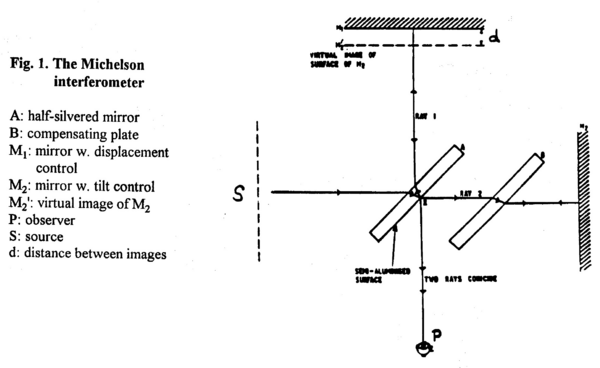Difference between revisions of "Main Page/PHYS 3220/Interferometer"
(Created page with "<h1>The Michelson Interferometer</h1> <p>In this experiment a Michelson interferometer is calibrated using a known mercury line, and then used to make a wavelength determination...") |
|||
| Line 9: | Line 9: | ||
| − | <table width= | + | <table width=600 align=center><td> |
| − | <p align=justify>[[File:Mic-fig1.png| | + | <p align=justify>[[File:Mic-fig1.png|600px|border|center]] |
<b>Figure 1 -</b> The Michelson Interferometer. | <b>Figure 1 -</b> The Michelson Interferometer. | ||
<br clear=right> | <br clear=right> | ||
Revision as of 14:00, 22 July 2011
The Michelson Interferometer
In this experiment a Michelson interferometer is calibrated using a known mercury line, and then used to make a wavelength determination for the Na doublet. In addition, the index of refraction of a piece of plastic, and that of air at room pressure is determined.
Introduction
The Michelson interferometer is well known for the role it played in finding that the speed of light is the same in every reference frame, and thus to begin the development of the special theory of relativity. It is a simple set-up by means of a half-silvered and two ordinary mirrors to split a beam of light into two, allowing one beam to travel a different path length than the other in order to superimpose them. Small variations in the path length difference d allow us to observe the wave nature of light, i.e., to observe how the two beams can add to produce an interference pattern. An observation of the interference pattern as d is changed allows us to draw conclusions about the wavelength of coherent monochromatic light.
An interferometer is one of several instruments to demonstrate the wave nature of light (ref. 1). Other important two-beam experiments are, e.g., the Fresnel mirror, Young’s double-slit experiment, a thin film, or a grating (cf. the spectrometer used in Expt 9). A more sophisticated version of the interferometer used extensively in research is the Fabry-Perot interferometer. Use the references to understand how these interferometers work and what is meant by spatial and temporal coherence of light coming from an extended source.
|
Figure 1 - The Michelson Interferometer.
|
In Fig. 1 the schematic diagram is shown for the M.I. with the semi-transparent mirror positioned at 45 degrees splitting the source beam into two halves that then travel toward the mirrors M1 and M2. The electric field associated with a monochromatic planar wave with circular frequency ω=2πc/λ, and wavenumber k=2π/λ is given by
